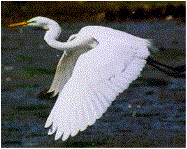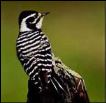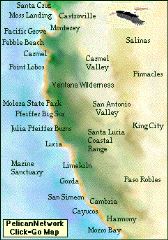|
Seasons in the Slough – Fall Equinox |
Elkhorn Slough is a Cradle of Life |
|
|
|
|
At the midpoint of Monterey Bay shoreline, Elkhorn Slough is a biological, cultural and geological channel for one of our planet’s richest ecosystems. |
|
|
|
This vast slough was the mouth of the Pajaro and Salinas Rivers until a hundred years ago when man rearranged the rivers to allow for more agriculture production. Now, Elkhorn is the gateway to one of the world’s most lucrative agricultural areas. |
|
Main channel of Elkhorn Slough with Moss Landing Power Plant |
||
|
The rivers have historically roamed all over the the two valleys, and endowed them with very rich soils. Each is among the most fertile and productive produce growing valleys in the world – renown for artichokes, strawberries, flowers, lettuce and wine grapes – due in most part to these rivers and the vast estuary where they meet the ocean. The rivers empty in the Monterey Bay where great underwater canyons –up to 12,000 ft. deep– carve through immense and intricate layers of marine life. The slough is home to 80 species of fish, hundreds of marine invertebrates, and more than 250 kinds of birds. |
 Photo by Margie Whitnah
|
||||||||||||||||||||||||
|
|
The Moss Landing Wildlife Area, managed by the California Dept. of Fish and Game, is a nearly natural salt marsh. It joins the Elkhorn Slough from the northwest, near the power plant. |
|||
|
Ever vigilant Cormorants keep an eye on the Slough. Even though such commonly constructed creatures, Cormorants are exquisite in their elegant watchfulness. Their patience is so disciplined, so intent, it is breathtakingly graceful. Here they look up slough as the tide recedes. A Gull reposes safe in the knowledge that should any fish arrive on the scene his sentinels will know. |
||
|
Sea Otter photos above and below by Margie Whitnah |
|||
Sea Otters – an endangered species that was thought extinct until the 1930s- are denizens of the Slough near the mouth at the harbor. |
 |
||
|
|
Hiking at Elkhorn Slough can be a feast for the mind, and the culinary senses. Interesting history abounds in the Slough. For example, there is the scene of the Empire Gun Club, a lodge on Hummingbird Island. Well heeled sportsmen from San Francisco would come by train to Elkhorn, a duck shooter’s paradise. The lodge had its own train station. Nowadays people come to see the waterfowl, not to kill them. Also, there are Indian middens, and pioneer homesteads. And, it is a feast for the gastronomic palette, also. As you hike around, looking at birds, bat rays and sharks in the slough channels, you can munch on wild delectables. Tasty choices include: fennel, rose hips, mugwort, mustard and radish. They are exquisite– and the docents know these treats – it’s like bringing Alice Waters on the hike. |
||
Birds put on a great show at the Slough. Those avionic dinosaurs, California Brown Pelicans, cruise up the slough returning from open ocean sorties, to hover around looking for the perfect patch of water to settle in and promptly take a loud floppy bath. Kestrels lurk from high wires, Egrets prance around, Herons stealth into shadows, acorn woodpeckers study old dead trees for the perfect sized hole, Terns ballet around little ripples in the water, Plovers, Avocets, Curlew, Dowitchers, Marbled Godwits, Willits, dance an endless choreograph in the tide pools. |
|
Elkhorn Slough winds seven miles over seven thousand acres. It is now part of a national effort to restore critical estuaries. Estuaries are important because they are the principal nesting, hatching and nursery areas for much wildlife. The National Estuarine Research Reserve System has selected 22 estuaries (2 in California, the other is the Tijuana Estuary) to provide coordination for public and private agencies; and, to conduct research and develop resources to rehabilitate the wetlands. |
Morning in Elkhorn Slough a proem by Karen Cotter |
||
|

|
|
|
Peter and Toni Young, wildlife docents for California Dept. of Fish and Game, spot birds for a tour group. |
Elkhorn Slough winds seven miles over seven thousand acres. It is now part of a national effort to restore critical estuaries. Estuaries are important because they are the principal nesting, hatching and nursery areas for much wildlife. The National Estuarine Research Reserve System has selected 22 estuaries (2 in California, the other is the Tijuana Estuary) to provide coordination for public and private agencies; and, to conduct research and develop resources to rehabilitate the wetlands. |
Efforts are being made to rid the Elkhorn Slough of toxic chemicals from man’s agriculture. Huge amounts of pesticide have run off into the slough, and caused tremendous damage. It was thought for a long time that the Elkhorn system was so vast, that it could not be seriously damaged by agricultural run off. There were even large dairy farms in the slough. Fortunately, a new respect for the natural slough is gaining momentum. |
 PelicanNetwork
is a cultural and natural history information advocacy
and PelicanNetwork
is a cultural and natural history information advocacy
and
Eco-Travel Guide to
California Central Coast Interactive
Map |
|


